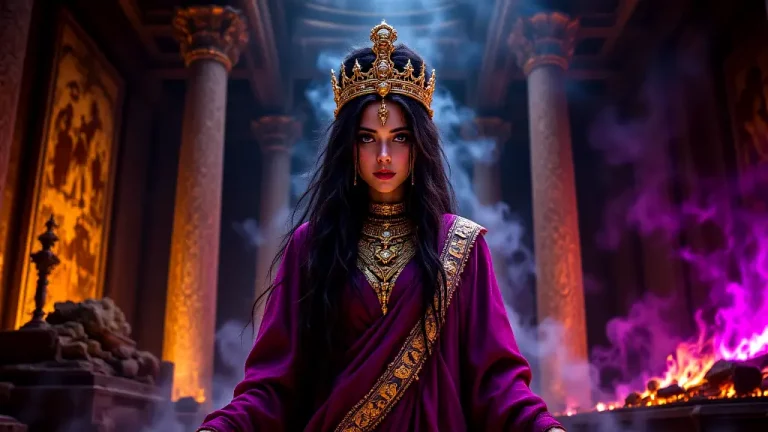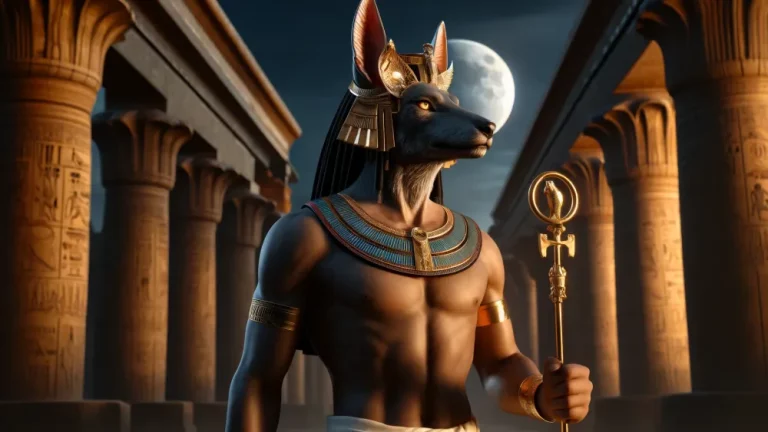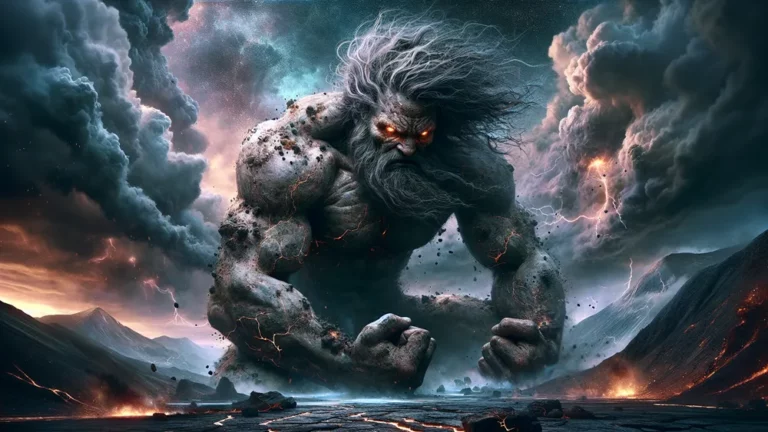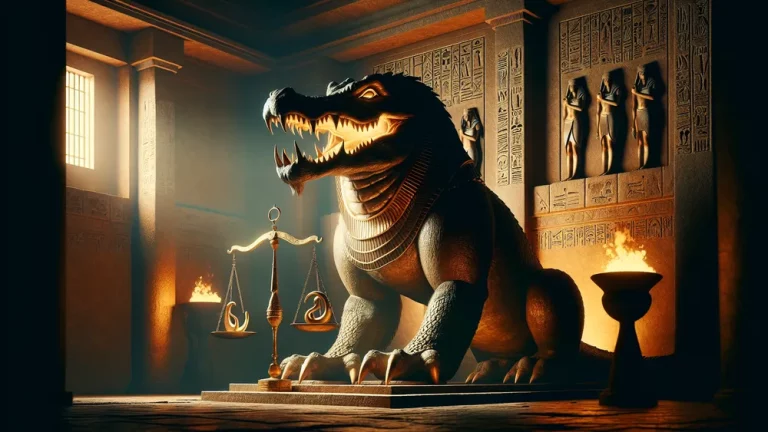Kokytos: The River Of Wailing In Greek Underworld Mythology
In the complex stories of Greek mythology, Hades’s Underworld is described as a place filled with both unique locations and meanings that go deep. Inside this area, the rivers are especially important because each stands for something specific about what happens after life ends. One of the most noticeable of these rivers is Kokytos (written as Cocytus in Latin), the “River of Wailing.”
Key Points:
- Kokytos in Greek mythology is the River of Wailing, symbolizing sadness and endless crying.
- The river is part of the Greek Underworld and flows as a tributary to Acheron, the River of Woe.
- It represents the sorrow of unburied souls, who are stuck crying near its banks.
- Homer, Hesiod, and Virgil wrote about Kokytos as a key part of the Underworld’s landscape.
- Kokytos reflects Greek beliefs in how burial rituals let the dead rest in peace.
- It is one of five main rivers in Hades, alongside Styx (oaths), Lethe (forgetting), Phlegethon (fire), and Acheron (grief).
- Stories of Orpheus, Persephone, Hercules, and others connect to Kokytos and its deeper meaning of grief and suffering.
This river passes through the dark area ruled by Hades, and it is tied forever to sadness and hopelessness that seem like they never stop.
Rivers we see every day might mostly mean life or being renewed, but the rivers in Hades are about ideas much larger than most people can easily connect to, and Kokytos stands for deep sadness that never fades and for tears that never dry up.
It could be pictured as a river where its sad waters seem to hold the endless sounds of pain, which makes it a lasting symbol of unfinished paths and spirits that cannot rest.
Even though it is not as well-known as the River Styx, the part Kokytos plays in these old myths is just as important because it focuses on subjects like bodies not buried properly, grief that never finishes, and fairness from the gods.
As we try to understand the old stories and writing about Kokytos more, we will see how this sad river moves not only through the Underworld, but also through the beliefs of ancient Greeks about life and death. This can give you a deeper understanding of a dark but interesting history connected to what some believed came after life.
Kokytos: Overview and Key Facts
| Key Aspect | Details |
|---|---|
| Name | Kokytos (from Ancient Greek: κοκυτός), often written as Cocytus in Latin. |
| Meaning of the Name | The name comes from the Greek word “κοκυτός,” which means “crying” or “wailing.” It is connected to sadness and grief in the world after death. |
| Location | It exists somewhere in Hades, the Underworld of Greek mythology. Where it is exactly is not always clear and changes depending on the source. |
| Type of River | It is a river tied to the Underworld. But unlike rivers on Earth, Kokytos stands for ideas like deep sadness instead of being a normal river. |
| Symbolism | Represents endless crying, suffering, and spirits who did not receive the proper burial or funeral traditions. |
| First Mention | It was written about first in Homer’s Odyssey (Book 10), where it is part of the Underworld’s layout. |
| Rivers Associated With | It is said to connect with Acheron, the “River of Woe,” and is part of the group of five main rivers in Hades, including Styx, Lethe, and Phlegethon. |
| Role in Mythology | A place for the souls of people without burial, which acts as a crossing for spirits when they enter the Underworld. It also calls up images of divine judgment or punishment. |
| Linguistic Note | In Latin, the word “cocytus” came to mean great grief or crying. It also influenced many literary and cultural ideas about sadness. |
| Notable Mentions | Found in books like Homer’s Odyssey, Hesiod’s Theogony, and Virgil’s Aeneid, where it is always tied to pain and sadness. |
The Beginnings of Kokytos: The River of Wailing
The beginnings of Kokytos, connected to its role in mythology as the “River of Crying,” are tied closely to ideas about sadness and rituals left incomplete. Through key myths and words from the past, people can see how this river affects old stories about death and punishment.
Kokytos gives an interesting look at how grief, unfinished traditions, and ancient beliefs shaped what ancient Greeks thought about life after death. What this river means in stories is sadness so deep it never ends, which connects it to important ideas about the Underworld.
How Kokytos Is Mentioned in Greek Myths
Kokytos, called the River of Crying, is seen again and again in Greek myths as part of stories about the Underworld. Its first mention is in Homer’s Odyssey (Book 10), where the river is described as part of the empty, sad world of Hades. Homer says that Kokytos flows into the larger river called the Acheron, making it part of the bigger system of rivers in the Underworld.
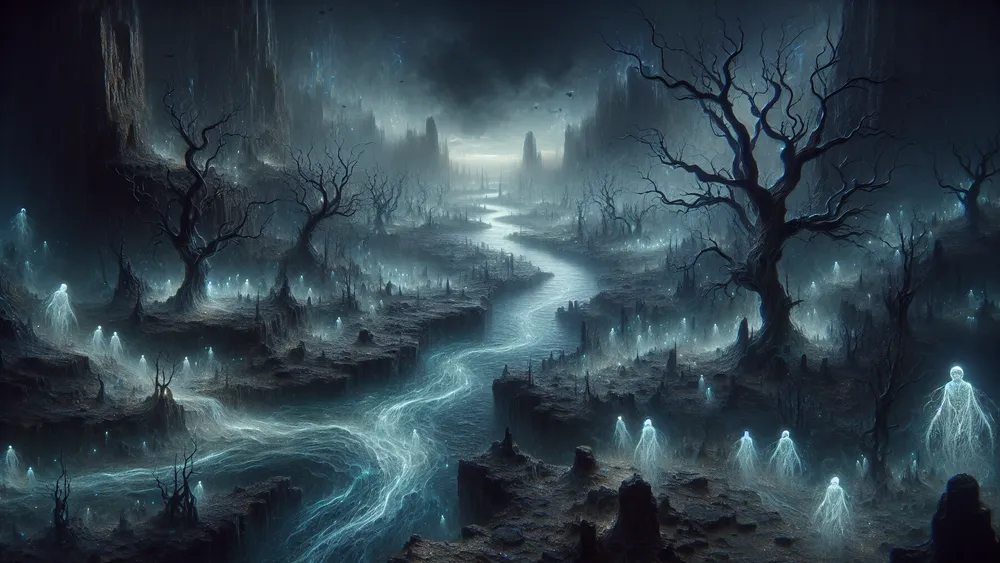
This writing connects Kokytos with sadness and crying and ties it to ideas about how the dead are treated after life. Hesiod’s Theogony talks about Kokytos too, putting it at the edges of the known world. There, Hesiod uses the river to explain the harsh end of death and why doing burial rites is critical, which is especially important in Greek religion.
Writers make Kokytos a part of stories about death over and over, which makes it clear this river stood for mourning. Later on, Virgil’s Aeneid (Book 6) explains more about Kokytos. In this book, which retells ideas about the Underworld from a Roman point of view, Virgil calls Kokytos a dark edge spirits cannot cross.
He writes about souls wandering near the river when they are not buried or cannot move into the next part of life after death. Their sadness matches the crying nature of the river itself. Virgil’s work takes ideas from older Greek writers but mixes them with Roman ways of telling stories.
Through all of these stories, Kokytos keeps being a river tied to sadness, grief, and the rules about death and memory.
- Key Mentions of Kokytos in Greek and Roman Texts:
- Homer’s Odyssey (Book 10): Talks about Kokytos as part of the empty and sad rivers of Hades, where it flows into Acheron.
- Hesiod’s Theogony: Uses Kokytos as an example of death and justice, tying it to religious rites.
- Virgil’s Aeneid (Book 6): Explains Kokytos as a border where some spirits wander, mixing Greek and Roman ideas.
Kokytos, the River of Crying, appears in Greek and Roman stories as a symbol of sadness, death, and the importance of burial rites, often linked to spirits unable to find peace.
Where the Name Kokytos Comes From
The name Kokytos comes from the old Greek word “κοκυτός” (kokytos). This word means “wailing” or “crying.” In the stories of Greek mythology, the name fits the river because it is tied to endless sadness. This river stands for grief and mourning, and in ancient Greek culture, these actions were very important. People would cry loudly and openly at funerals, showing how deeply they felt the loss of someone.
The name Kokytos also connects to this cultural focus on mourning, and the river is part of myths about death and what happens after. In ancient Greece, proper burial traditions mattered. Kokytos was seen as a river for those who did not receive the right funeral ceremonies.
Words tied to the river explain this idea clearly, placing it as part of the crying connected to the unburied dead. Roman writers, such as Virgil, kept the same name in Latin, where it still explained deep and unresolved sadness. This meaning, carried across Greek and Roman stories, highlights how strong the idea of mourning was in both cultures.
Kokytos became a direct expression for grief, one that connects the living to the dead through their cries.
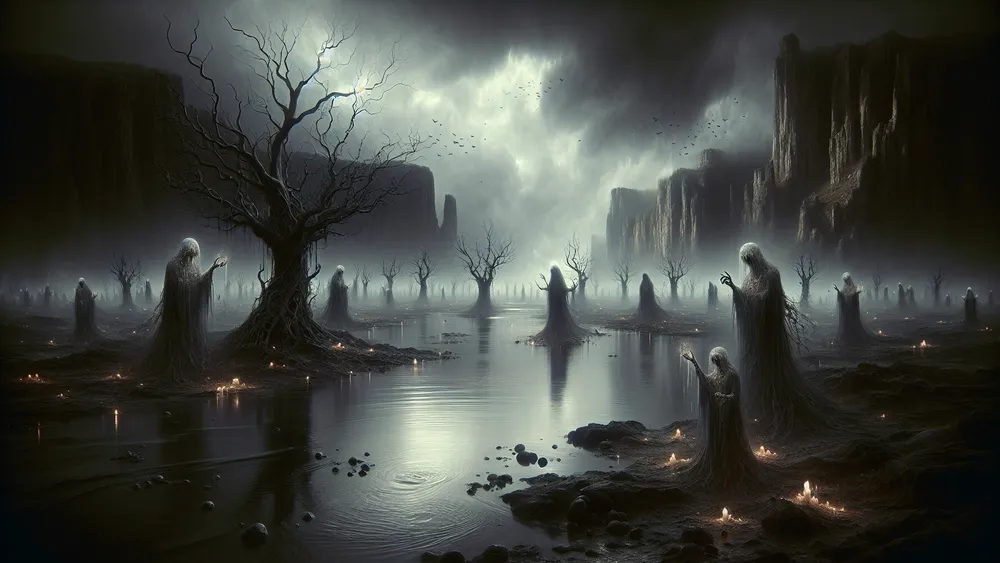
Kokytos and the Landscape of the Underworld
To fully understand why Kokytos matters, it is important to think about where it fits into the detailed layout of the Greek Underworld. The rivers in Hades are linked, and each one has its own purpose. Kokytos is one of them. In Hades, there is a system of rivers that connect and make up parts of this dark world.
And Kokytos plays a sad part in this setup. Let’s look at how these rivers fit together and what specific parts Kokytos has there.
The Five Rivers of Hades Side by Side
In Greek myths, the Underworld is connected through five rivers, each one with its own job. These rivers – Styx, Lethe, Phlegethon, Acheron, and Kokytos – are not just parts of a map, but things with meaning, tied to ideas about death and the world after. You might know the river Styx, which is famous because even gods had to keep their promises made on it.
But all the rivers mattered in how people thought about Hades. For example, Kokytos means endless sadness, and Lethe is about forgetting, since it erased memories for anyone who drank from it. Phlegethon, a river full of fire, was written about by Plato, who called it dangerous but also able to clean.
Then there is Acheron, called the “River of Woe,” which people thought of as a doorway to the Underworld. Together, they explain different feelings tied to death, like sorrow, fairness, and being born again.
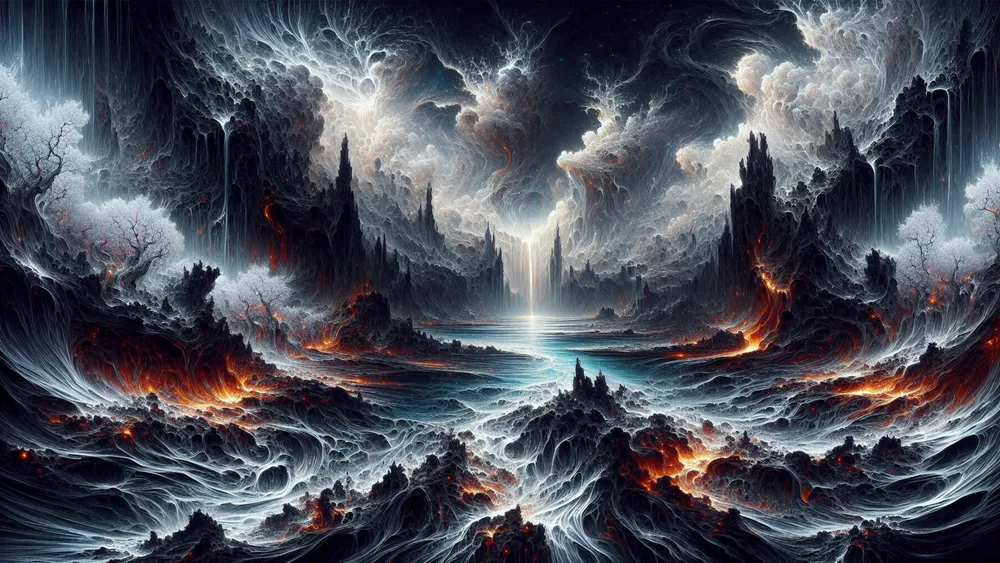
If you think of these rivers as the main paths of the Greek Underworld, you can see how each one fits into the bigger design. Water often meant change or boundaries for the Greeks. Below is a table to help explain their names, jobs, and meanings:
| River Name | Literal Meaning | What It Does | What It Stands For | Famous Stories |
|---|---|---|---|---|
| Styx | Hatred | Keeps oaths; boundary river | Promises and strict rules | In Hesiod’s Theogony and Homer’s stories |
| Lethe | Forgetfulness | Makes people forget; tied to rebirth | Memory loss and starting over | In Plato’s Republic and Virgil’s Aeneid |
| Phlegethon | Burning/Flaming | River of fire; cleans or destroys | Punishment and cleaning through fire | In Plato’s Phaedo and other myths |
| Acheron | Woe/Grief | Entry river to the Underworld | Sadness and crossing over | In Homer’s Odyssey and Virgil’s Aeneid |
| Kokytos | Wailing/Lamentation | Tributary of Acheron; tied to cries | Sorrow and restless spirits | In Homer’s Odyssey and Virgil’s Aeneid |
The rivers explain how the Greeks saw death as something both sad and full of change. By linking them together, the world of Hades becomes one big system that matches these ideas.
How Kokytos and Acheron Work Together
Kokytos and Acheron are closely linked, forming part of the rivers of the Underworld. Kokytos is a tributary that runs into Acheron, which is the bigger and more well-known of the two.
In Greek myths, Acheron is described as the main river that souls need to cross to get into Hades, while Kokytos stands for the endless cries of souls not buried or those who remain in suffering near its edges. You could think of Kokytos as a smaller and sadder stream moving into the wide and terrible Acheron.
This link between the two rivers gives a clear idea of sorrow and grief. Acheron represents the general path into death and mourning. Meanwhile, Kokytos adds to this by focusing on the despair of souls that have not fully crossed over, especially those who were not buried properly. Together, they represent key ideas about death in Greek thinking.
For the ancient Greeks, having the right funeral and rituals was very important to finding peace after death. These two rivers, in their stories and meanings, show how much this belief mattered. Kokytos and Acheron depend on each other both in what they mean and in the way they fit into the Underworld‘s layout.
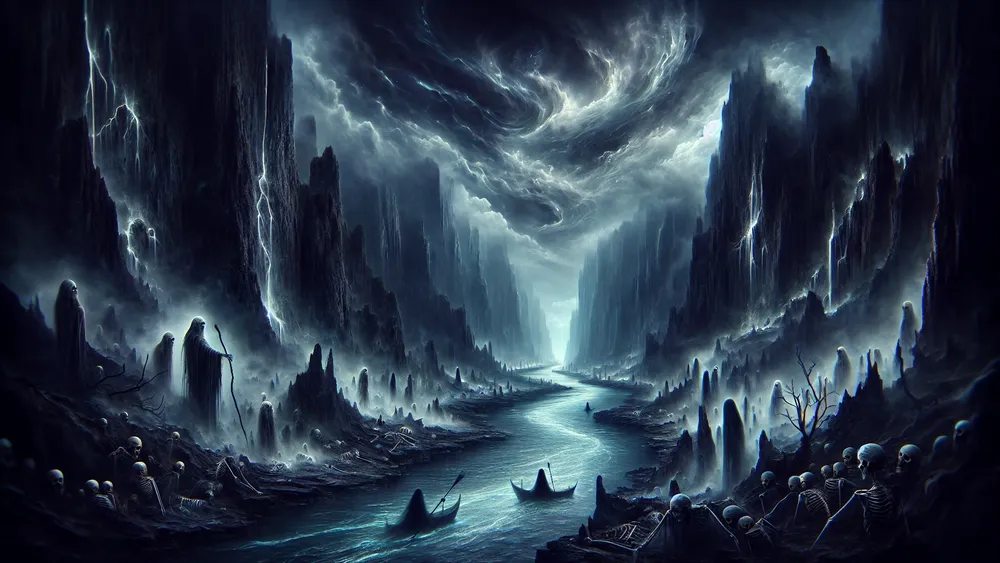
What Kokytos Stands for in Greek Myths
We already explored where Kokytos fits in the world of Hades. Now it is time to look at what it means and the deeper ideas tied to it. Kokytos stands for sadness, suffering, and the endless cries of souls that cannot find peace. It is a river connected to despair and punishment in Greek myths.
Next, we will see how its meaning is built from the emotions and fates of the dead who remain incomplete in their journey.
Kokytos and the Idea of Endless Suffering
Kokytos, called the “River of Wailing,” is a strong symbol of never-ending suffering in Greek myths. It stands for the cries of souls that were not buried, the ones who could not find peace, and the people stuck without rest. In these stories, souls near Kokytos are trapped in sadness. Their cries fill the space around the river as they wander nearby, endlessly grieving.
Ancient Greek beliefs about rightful funerals make this meaning clearer. Without a proper funeral, a soul stayed in grief, unable to cross into the next life. For the Greeks, this was part of their ideas about death, where rituals were important for finding peace. Think of Kokytos not as a river of water.
Instead, it is like a loud river filled with voices, a place where sadness and pain never stop. This idea is part of how Greeks thought about punishment and morality in their world. Souls without funerals were denied closure, left to stay in grief forever.
The following key ideas are tied to Kokytos:
- Crying for the Unburied: Souls without funerals could not cross, so their voices stayed near Kokytos.
- Punishment for Wrongdoing: The river stands for the pain of souls judged for their actions in life.
- Shared Sadness: Kokytos gathers the sorrow of dead souls into one place.
- Unfinished Journeys: The river means the pain of souls who could not move on, showing how important funerals and rituals were.
Together, these ideas connect Kokytos with sadness and judgment. In Greek myths, it was a reminder of how funerals and remembrance mattered for finding peace after death.
Different Cultures’ Views of Kokytos
Kokytos is not the only example of sorrow, punishment, and being between two states. You can find similar ideas in other myths across cultures. In Roman stories, influenced by Greek ones, Virgil’s Aeneid includes Kokytos during Aeneas’s trip to the Underworld. There, it is still linked to mourning and grief.
In ancient Egyptian ideas about the afterlife, rivers in the Duat (their version of the Underworld) acted as obstacles or challenges for dead souls. These rivers, like the waters of the Nile or the Watery Abyss, made it hard for souls to reach their final fate. This is similar to Kokytos, where souls without burial rituals were stuck and unable to move forward. One idea connects all this – rivers as barriers for the dead.
The Norse river called Gjöll is another example. Near the bridge Gjallarbrú, it creates a line between life and death. This is like the role of Kokytos and the Acheron. But while Gjöll does not carry the endless cries of sorrow, it still fits with the common belief that rivers separate this life from the next.
In Indian myths, the Vaitarna River plays a similar role, stopping sinners as they try to reach the afterlife. These ideas about rivers describe how many groups thought of death – not as a peaceful journey, but as a hard path full of limits and judgment. Through all these examples, different myths use rivers to explain the mystery of death.
Kokytos is just one part of this shared way of describing fear, sadness, and what comes after life.
Different cultures used rivers in myths to explain death as a difficult and uncertain journey, with Kokytos being one of many examples of sorrow and obstacles for the dead.
Tales and Legends About Kokytos
We already looked at what Kokytos means and how it has similar ideas in other cultures. Now, we can focus on the specific myths where this cold and frightening river is important. These stories explain how Kokytos is part of Greek beliefs about the afterlife.
Next, the myths we will look at will help us understand Kokytos’s role in shaping what the Greeks thought happened after death. It is an essential river. Through these stories, we will see how rivers like Kokytos mattered in their ideas about the world of the dead.
The Spirits of Kokytos: What Happens to the Unburied
In Greek myths, the fate of unburied souls was sad and closely tied to the river Kokytos. The souls of the unburied, called ataphoi (which means “without burial”), were forced to stay near its shores, always crying in pain. A proper burial was more than tradition – it was a critical ceremony that helped a soul pass into the afterlife.
Without this, the dead could not cross the river Acheron to enter Hades’s realm, leaving them stuck near Kokytos. These spirits wandered in a dark place, their voices crying not just for peace but also to be remembered. The way ancient Greeks thought about life and death made funerals very important. Without them, the balance between the living and the dead was broken.
In Homer’s Odyssey, a clear example of this happens when Elpenor’s ghost asks Odysseus to bury him after dying in a meaningless way. His request shows the sadness of spirits who had no funeral, unable to find peace. Similarly, Sophocles’s story of Antigone describes her fight to bury her brother Polynices, despite King Creon’s order against it.
Without his funeral, his soul would suffer, perhaps staying near Kokytos, filled with endless grief. These spirits also give another message: anything left unfinished stays around. Their crying shows a kind of chaos where the dead cannot rest. The Greeks believed that rituals like burial, or giving coins to the ferryman Charon, helped bring balance. Without these, the dead would stay stranded.
Key ideas about these unburied souls include:
- Wandering Near Kokytos: Without funerals, souls stayed near the river, unable to enter the afterlife.
- Crying Without Peace: Their voices reflected grief and the loss of hope.
- Why Funerals Matter: Stories like Elpenor’s in Odyssey or Antigone’s struggle explain why this ceremony was so important.
- Chaos From Neglect: Forgetting funerals disrupted the natural order, leaving souls in pain.
Through these stories, Kokytos is more than just a river. It represents the sadness and pain caused by forgetting duties to the dead. This pain was for the dead and for the living too.
Orpheus, Persephone, and Journeys Through Kokytos
The story of Orpheus is one of the most emotional in Greek myths, and his journey into the Underworld gives us a glimpse of the cold and dangerous world of Hades, where Kokytos flows among other rivers of sadness. Orpheus, known for playing beautiful music, went into Hades to try and bring back his wife, Eurydice, after her death.
With only his lyre, his songs were powerful enough to touch even the gods and spirits of the dead. His music is believed to have reached the river Kokytos, mixing with the never-ending cries from the dead souls stuck there.
Even though some myths, like Ovid’s Metamorphoses, do not mention Kokytos in the story, the river and its grief-filled cries still represent the sadness and hopelessness of his failed attempt to save her. Orpheus’s journey is a story about love, loss, and the limits of escaping death. Persephone, queen of the Underworld, is deeply connected to Kokytos as well.
As someone who moves between life and death, she rules over those cycles of mourning and rebirth. She isn’t just the ruler of the dead; she also represents balance in the Greek view of death, where rivers like Kokytos always remind the dead of sadness and the fact that life ends.
Her story, where she is taken down to Hades but later returns to Earth, is tied to Kokytos, which represents similar cycles of sadness and life. The loud cries around Kokytos reflect not only her sorrow at being taken to the Underworld but also her power as she balances living and dead souls.
She is both someone who suffered and someone who rules, just like the river both traps and defines the sorrow of the dead. Although the myths of Orpheus and Persephone are separate, Kokytos connects them through the shared ideas of grief, change, and life ending. Orpheus tries to fight death and bring back life.
Persephone, in contrast, stands for accepting death as part of how things work. The river Kokytos isn’t just a place but a symbol, full of cries that feel like Orpheus’s sad songs and Persephone’s role as queen. Together, their stories and the river remind us that life and death are always connected, and both sadness and peace are part of those connections.
Hercules and Kokytos: Facing the Underworld
During his last job, Hercules was given the challenge of going into the Underworld to take Cerberus, the three-headed dog guarding the gates. The Underworld, a dark place filled with sadness, was home to rivers like Kokytos, where the cries of the dead could always be heard.
When Hercules entered this world, he came face to face with deep fears and the kind of sorrow that mortals avoided during their lives. It was overwhelming. But Hercules, with all his strength, moved forward. Ancient stories like Apollodorus’s Bibliotheca and Virgil’s Aeneid focus on many parts of Hercules’s journey into Hades.
Even though some don’t talk much about Kokytos, it can still be seen as part of the sad and frightening challenges he had to face. This river, with its sounds of endless pain, added to the heavy emotions of his journey. The waters of Kokytos seemed like a reflection of the struggles Hercules went through – not just physical ones, but also those testing his will to go on.
Hercules was one of the few mortals who could enter this land of fear and come back alive. The images of rivers like Kokytos would have reminded those hearing his story of the mental strength it took to survive such sadness and despair. It wasn’t just a test of his body. It was also a test of his spirit.
In the end, he returned with Cerberus, proving his unmatched strength to face both the physical and emotional trials of life and death.
Homer’s Version of Kokytos in the Odyssey
In Homer’s Odyssey, Kokytos is mentioned briefly during Odysseus’s journey to the Underworld in Book 11, called the Nekyia. According to Homer, Kokytos flows into the larger river Acheron, one of the main rivers of Hades, and he points out how sad and grim it seems.
This quick mention makes Kokytos a key part of the Underworld’s layout, tying it to the dark, unfriendly setting where Odysseus must go to speak to the spirits of the dead. Although Homer does not describe much about the river, just knowing it is there helps explain the grief and sorrow that fill this land. For Odysseus, being in such a place makes his mission feel even heavier and stranger.
He has to call on the ghosts to help him, standing near a river that mixes the cries of its waters with the voices of the dead. It must have felt lonely and frightening. At the point where life ends and another existence begins, Homer includes Kokytos. It meets Acheron, and together, they represent sadness and suffering – Kokytos as the cries of unresolved pain and Acheron as the flow of constant sorrow.
The two rivers together shape the dark world that Odysseus has to pass through. Homer does not give physical details about Kokytos, but its emotional weight is clear, making readers imagine the sadness tied to its name. For Odysseus, a mortal entering a place meant for gods and spirits, Kokytos seems like one more test.
Facing it is not just about strength, but about handling all the sadness and fear that come with understanding what it means to be mortal, and to die.
Kokytos, a sorrowful river in Hades linked to grief and cries, adds to the heavy and unsettling atmosphere of Odysseus’s journey to confront death’s reality.
All the Places from Greek Myths
Greek myths are closely tied to places, which include all kinds of locations – mountains, rivers, caves, and even cities. These weren’t just the settings where the stories happened. They meant something bigger. Places like Mount Olympus, the river Styx, and the maze in Crete helped connect important ideas, such as life, death, and big changes, to real, physical locations.
If you are curious and want to learn about all these places and their roles, you can see a full list of Greek Geographical Concepts to find out how they started, what they were used for, and what they meant. From the very top of Mount Olympus to the dark depths of the Underworld, these locations gave structure to the ancient world.
Even now, they grab the attention of audiences, helping us imagine how the ancient Greeks thought about their gods, their world, and everything in between.
FAQs
1. What is Kokytos in Greek Mythology?
Kokytos in Greek mythology is one of the five rivers of the Underworld, symbolizing endless wailing and despair.
2. How is Kokytos Different from Styx?
Kokytos is different from Styx because it embodies the sorrowful wailing of the unburied dead, while Styx represents inviolable oaths and divine boundary.
3. What Happens to Souls Near Kokytos?
What happens to souls near Kokytos is that they are condemned to wail in eternal anguish, especially if they were denied proper burial rites.
4. Are There Rivers Similar to Kokytos in Other Mythologies?
There are rivers similar to Kokytos in other mythologies, such as the Norse Gjöll and certain rivers in the Egyptian underworld, which also symbolize sorrow and transition in the afterlife.


